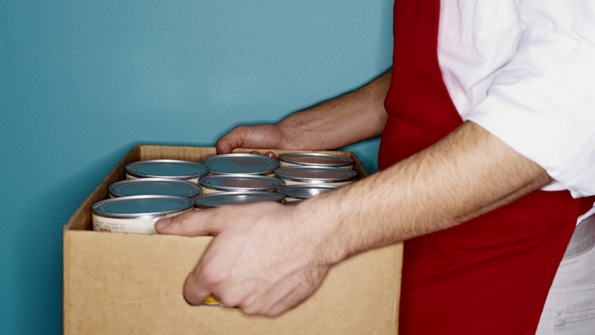October 30, 2015

America wastes a whopping 40 percent of our post-harvest food supply, according to a Johns Hopkins study published in June. Yikes! Although consumers are responsible for a large part of that, grocers and foodservice operators are on the hook too. As a retailer committed to keeping people and the planet healthy, you’re already making solid efforts to avoid wasting food in-store. But is there even more you can do? Probably. Here are nine expert tips.
Food Waste Reduction Specialist
Janet Haugan, director of marketing at LeanPath Inc. in Portland, Oregon
Start tracking food waste. Measuring what you’re wasting is essential. Data is key to identifying opportunities for improvement, so  record food waste daily. Even if you’re not ready to invest in a system like one of LeanPath’s, which show the monetary value and environmental impacts of wasted food and take photos to help assess what can be reused, just start tracking. Download our logbook for free at leanpath.com, or make your own.
record food waste daily. Even if you’re not ready to invest in a system like one of LeanPath’s, which show the monetary value and environmental impacts of wasted food and take photos to help assess what can be reused, just start tracking. Download our logbook for free at leanpath.com, or make your own.
Get scrappy. Before composting food scraps, try repurposing them. Vegetable trimmings like celery leaves can add a lot of flavor to soups and stews; freeze them until you have enough for a stock. Potato peels can be fried and turned into snacks. Use leftover pizza dough for breadsticks and cake trimmings to make cake pops or trifles. There are endless recipes for repurposing day-old food.
Retool your salad bar. Salad bars can be a huge source of waste because of many of the ingredients’ short shelf lives and how customers perceive freshness. They want to see beautiful, bountiful vegetables, and no one wants to the take the tail end of a pan. Instead of using deep pans, use shallow ones that create the look of abundance while holding less product. Or at least rotate in smaller pans once demand winds down. You can also close the bar and switch to premade grab-and-go salads in the evening.
Federal Government Official
Mathy Stanislaus assistant administrator of the Environmental Protection Agency’s Office of Solid Waste and Emergency Response
Take the EPA Food Recovery Challenge. We help businesses audit their programs and implement tracking systems so they can commit to waste-reduction goals. Oftentimes,  businesses learn they don’t have the best mechanisms in place for purchasing and using food effectively. In 2013, participants reduced the amount of wasted food by 370,000 tons. We offer a number of helpful free resources at epa.gov/osw/conserve/foodwaste/fd-tools_rescrs.htm.
businesses learn they don’t have the best mechanisms in place for purchasing and using food effectively. In 2013, participants reduced the amount of wasted food by 370,000 tons. We offer a number of helpful free resources at epa.gov/osw/conserve/foodwaste/fd-tools_rescrs.htm.
Donate leftovers. The first step in the EPA’s Food Waste Recovery Hierarchy is source reduction. The next step is feeding hungry people. Donate to food shelters and other nonprofits; some will even come to you to pick up goods. Businesses often fear liabilities associated with donating food, but the Good Samaritan Food Donation Act legally protects those that give in good faith.
Educate customers. A tremendous amount of wasted food comes from consumers’ homes, usually due to lack of awareness. Either they misunderstand sell-by dates and toss items prematurely or they just have bad purchasing behaviors. A lot of engagement and education can happen at the retail level. Many retailers find that when they help shoppers better understand how to buy and cut down on waste, it really enhances the customer experience.
Retailer
Diana Chapman, director of sustainability at PCC Natural Markets in Seattle
Stock small, stock often. Maintain great stock conditions with smaller and more frequent orders of fresh items. This is especially key with milk because shoppers will date-sort, and you want to be  circulating out the freshest product. Regular produce rotation and chilling are also paramount, especially with soft fruit crops.
circulating out the freshest product. Regular produce rotation and chilling are also paramount, especially with soft fruit crops.
Adjust inventory to meet varying demands. Carefully monitor your movement by category so you can use historic data to anticipate future needs and prevent waste. This sounds obvious, but it takes a lot of experience to do right. Our veteran prepared foods teams know that during school vacations or certain holidays, demand for particular items will be up or down. Also be ready to adjust according to weather. We had unprecedented hot weather in Seattle this summer so everyone was picnicking, not cooking. Our smoothie bar and grab-and-go sales shot up.
Repurpose unsold product. At some PCCs, food scraps from our fresh departments are processed to be made into liquid fertilizer through onsite WISErg Harvester units. At other stores, scraps or unsellable products that can’t be donated are hauled off and made into compost. The fertilizer and compost are sold at all of our stores. The Harvesters tell us the source, volume and weight of all food scraps, so we can see if one store has X amount of scraps while another has Y or Z amount.
About the Author(s)
You May Also Like
.png?width=700&auto=webp&quality=80&disable=upscale)




